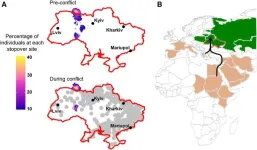(Press-News.org) CORVALLIS, Ore. – Researchers have developed a new theory of how changing market conditions can lead large numbers of otherwise cautious consumers to buy risky products such as subprime mortgages, cryptocurrency or even cosmetic surgery procedures.
These changes can occur in categories of products that are generally low risk when they enter the market. As demand increases, more companies may enter the market and try to attract consumers with lower priced versions of the product that carry more risk. If the negative effects of that risk are not immediately noticeable, the market can evolve to keep consumers ignorant of the risks, said Michelle Barnhart, an associate professor in Oregon State University’s College of Business and a co-author of a new paper.
“It’s not just the consumer’s fault. It’s not just the producer’s fault. It’s not just the regulator’s fault. All these things together create this dilemma,” Barnhart said. “Understanding how such a situation develops could help consumers, regulators and even producers make better decisions when they are faced with similar circumstances in the future.”
The researchers’ findings were recently published in the Journal of Consumer Research. The paper’s lead author is Lena Pellandini-Simanyi of the University of Lugano in Switzerland.
Barnhart, who studies consumer culture and market systems; has researched credit and debit in the U.S. Pellandini-Simanyi, a sociologist with expertise in consumer markets, has studied personal finance in European contexts. Together they analyzed the case of the Hungarian mortgage crisis to understand how people who generally view themselves as risk averse end up pursuing a high-risk product or service.
To better understand the consumer mindset, the researchers conducted 47 interviews with Hungarian borrowers who took out low-risk mortgages in the local forint currency or in higher risk foreign currency as the Hungarian mortgage industry evolved between 2001 and 2010. They also conducted a larger survey of mortgage borrowers, interviewed 37 finance and mortgage industry experts and financial regulators and analyzed regulatory documents and parliamentary proceedings.
They found patterns that led to mortgages becoming riskier over time and social and marketplace changes that lead consumers to enter into a state of collective ignorance of increasing risks. In addition, they identified characteristics that encouraged these patterns. Other markets with these characteristics are likely to develop in a similar way.
“Typically, when there is a new product on the market, people are quite skeptical. The early adopters carefully examine this product, they become highly educated about it and do a lot of work to determine if the risk is too high,” Pellandini-Sumanyi said. “If they deem the risk too high, they don’t buy it.”
But if those early adopters use the new product or service successfully, the next round of consumers is likely to assume the product will work for them in a similar fashion without examining it in as much detail, even if the quality of the product has been reduced, the researchers noted.
“Then everything starts to spiral, with quality dropping in the rush to meet consumer demand and maintain profits, and consumers relying more and more on social information that suggests this is a safe purchase without investigating how the risks might have changed,” Barnhart said.
“It also can lead to a ‘prudence paradox,’ where the most risk averse people wait to enter the market until the end stages and end up buying super risky products. They exercise caution by waiting but they wait so long, they end up with the worst products.”
The spiral is typically only broken through intervention, either through market collapse or regulation. For example, while cosmetic surgery is relatively safe, an increase in availability of inexpensive procedures at facilities that lacked sufficient equipment and expertise led to a rise in botched procedures until regulation caught up.
“These findings demonstrate the power of social information,” Barnhart said. “In this environment, it’s very difficult for any individual consumer to pay attention to and assess risk because doing so is so far outside of the norm.”
To protect themselves against collective ignorance, consumers should ensure that they are weighing their personal risk against others whose experiences are actually similar, Pellandini-Sumanyi said.
“Make sure this is an apples-to-apples comparison of products and the consumers’ circumstances,” she said.
END
Evolving market dynamics foster consumer inattention that can lead to risky purchases
2024-05-20
ELSE PRESS RELEASES FROM THIS DATE:
Ex-cigarette smokers who vape may be at higher risk for lung cancer
2024-05-20
EMBARGOED UNTIL: 9:15 a.m. PT, May 20, 2024
Session: B20 – Lung Screening: One Size Does Not Fit All
Association of Electronic Cigarette Use After Conventional Smoking Cessation with Lung Cancer Risk: A Nationwide Cohort Study
Date and Time: Monday, May 20, 2024, 9:15 a.m. PT
Location: San Diego Convention Center, Room 30A-B (Upper Level)
ATS 2024, San Diego – Former cigarette smokers who use e-cigarettes or vaping devices may be at higher risk for lung cancer than those who don’t ...
The impacts of climate change on food production
2024-05-20
A new peer-reviewed study from researchers at The University of Texas at Arlington; the University of Nevada, Reno; and Virginia Tech shows that climate change has led to decreased pollen production from plants and less pollen more diversity than previously thought, which could have a significant impact on food production.
“This research is crucial as it examines the long-term impacts of climate change on plant-pollinator interactions,” said Behnaz Balmaki, lead author of the study and an assistant professor of research in biology at UTA. “This study investigates how shifts in flowering times and extreme weather events affect the availability of critical food ...
Mothers live longer as child mortality declines
2024-05-20
ITHACA, N.Y. – The dramatic decline in childhood mortality during the 20th century has added a full year to women’s lives, according to a new study.
“The picture I was building in my mind was to think about what the population of mothers in the U.S. looked like in 1900,” said Matthew Zipple, a Klarman Postdoctoral Fellow in neurobiology and behavior at Cornell University and author of “Reducing Childhood Mortality Extends Mothers’ Lives,” which published May 9 in Scientific Reports.
“It was a population made up of two approximately equal-sized ...
Study reveals promising development in cancer-fighting nanotechnologies
2024-05-20
A new study conducted by the Wilhelm Lab at the University of Oklahoma examines a promising development in biomedical nanoengineering. Published in Advanced Materials, the study explores new findings on the transportation of cancer nanomedicines into solid tumors.
A frequent misconception about many malignant solid tumors is that they are comprised only of cancerous cells. However, solid tumors also include healthy cells, such as immune cells and blood vessels. These blood vessels are nutrient transportation ...
Fat cells influence heart health in Chagas disease
2024-05-20
Jyothi Nagajyothi, Ph.D. and her laboratory at the Hackensack Meridian Center for Discovery and Innovation (CDI) have identified what may be the main mechanism for how chronic Chagas Disease, a parasitic infection affecting millions of people worldwide, can cause irreversible and potentially fatal heart damage.
The culprit is in the adipose (fat tissue) which the parasite Trypanosoma cruzi destroys in the course of infection, releasing smaller particles which induce the dysfunction of heart tissue, conclude the scientists in the journal iScience, a Cell Press open-access journal.
“We are attempting to understand this ...
C-Path’s TRxA announces its first biologics-focused RFP for academic investigators
2024-05-20
TUCSON, Ariz, May 20, 2024 – Critical Path Institute’s (C-Path) Translational Therapeutics Accelerator (TRxA) today announced its inaugural biologics-focused Request for Proposals (RFP) in its Bridging Research and Innovation in Drug Development Grants program (BioBRIDGe). BioBRIDGe awards are designed to help academic researchers traverse the drug development valley of death by providing funding and defining optimal strategies for advancing new, cutting-edge protein-based therapeutics (PBT) from the lab to patients.
For this funding cycle, ...
Enhancing superconductivity of graphene-calcium superconductors
2024-05-20
Superconductors are materials that can conduct electricity with zero resistance when they are cooled below a certain critical temperature. They have applications in several fields, including magnetic resonance imaging, particle accelerators, electric power, and quantum computing. However, their widespread use is limited by the need for extremely low temperatures. Graphene-based materials are promising for superconductors due to their unique properties such as optical transparency, mechanical strength, and flexibility. Graphene is a single layer of carbon (C) atoms arranged in a two-dimensional honeycomb structure. Among these materials, ...
Federal Trade Commission actions on prescription drugs, 2000-2022
2024-05-20
About The Study: The Federal Trade Commission (FTC) brought about one enforcement action and three merger actions per year against pharmaceutical manufacturers from 2000-2022, pursuing a small fraction of the estimated misconduct and consolidation in the pharmaceutical marketplace. Although the FTC faces substantial legal and practical limitations, important tools remain untested, including a rule defining “unfair methods of competition,” that may allow it to more effectively prevent repetitive patterns of anticompetitive behavior.
Corresponding Author: To contact the corresponding author, Aaron S. Kesselheim, ...
Fluoride exposure during pregnancy linked to increased risk of childhood neurobehavioral problems, study finds
2024-05-20
Nearly three-quarters of the United States population receives drinking water that contains fluoride, a practice that began in 1945 to help prevent tooth decay. But recent studies suggest that fluoride exposure can cause harm to a fetus if consumed during pregnancy, a critical period for brain development.
A new study, led by researchers at the Keck School of Medicine of USC and funded in part by the National Institutes of Health, analyzed more than 220 mother-child pairs, collecting data on fluoride levels during pregnancy and child behavior at age three. The researchers found that a 0.68 milligram per ...
The Ukraine war caused migrating eagles to deviate from their usual flight plan
2024-05-20
When migrating through Ukraine in 2022, Greater Spotted Eagles were exposed to multiple conflict events that altered their migratory course, according to a study reported on May 20 in the journal Current Biology. Greater Spotted Eagles are large raptors that are classified as a vulnerable species by the International Union for Conservation of Nature (IUCN).
“Armed conflicts can have wide-ranging impacts on the environment, including changes in animal behavior,” says Charlie Russell (@CJG_Russell) of the University of East Anglia, UK. “Our ...





